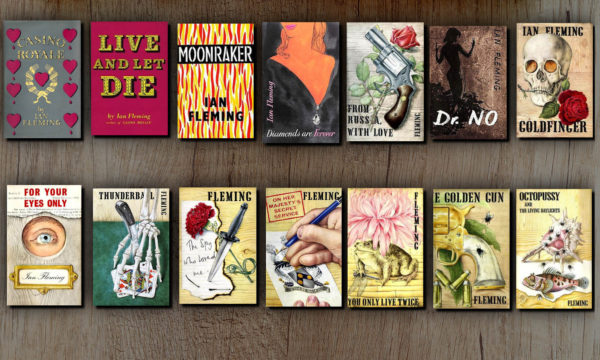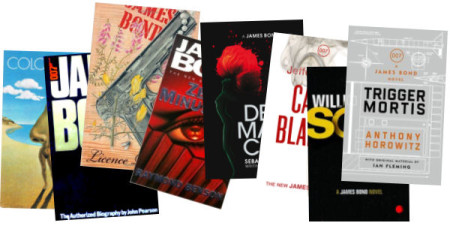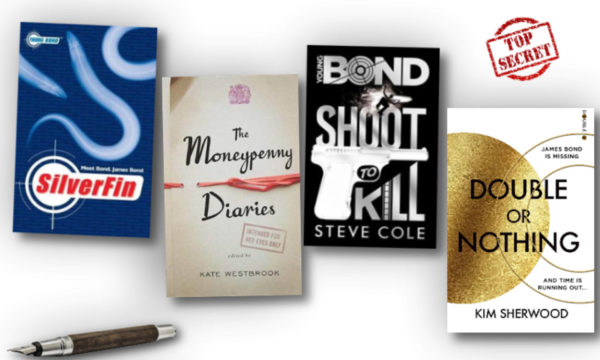Every single book by every author in the expanded James Bond literary series.

James Bond is a name that echoes through the world of fiction, capturing the hearts of readers for decades. Created by Ian Fleming, a man with real-life experience in the world of espionage, James Bond 007 came to life in the 1953 novel Casino Royale. This character set the standard for the spy genre, with his unmatched charm and distinctly British flair, moving through the dangerous world of spies with ease and style.
In this article
In this article, we’ll explore the James Bond literary series in detail. We’ll look at Fleming’s original novels, the work of authors who took on the Bond mantle after him, and the key themes that run through the stories. Whether you’re new to Bond’s literary world or a long-time fan keen to dive back into these classic tales, this guide is designed to deepen your appreciation of one of literature’s most iconic characters.
Ian Fleming: the man who created 007
Ian Fleming, a former naval intelligence officer, transformed his wartime experiences into the fabric of James Bond’s world. In 1953, Casino Royale not only introduced a character but also set a new benchmark for the spy genre. Fleming’s Bond was a blend of sophistication, resilience, and moral complexity, traits that mirrored the post-war era’s uncertainties and hopes.

Over twelve novels and two collections of short stories, Fleming crafted a legacy that transcended time. His ability to amalgamate thrilling espionage with deep character exploration made Bond not just a spy, but a literary icon. Fleming’s works, rich in the ambiance of the Cold War era, continue to captivate by offering a window into the geopolitical tensions of the mid-20th century.
- Casino Royale (1953): The book that introduced James Bond to the world. Here we see Bond in northern France, taking on the sinister Le Chiffre in a high-stakes game of baccarat.
- Live and Let Die (1954): Bond faces the challenges of the Cold War, battling a dangerous criminal who threatens the US with disaster.
- Moonraker (1955): A mission that starts with the investigation of a cheating scandal leads Bond to uncover a plot against Britain.
- Diamonds Are Forever (1956): Bond’s journey takes him into the heart of the diamond smuggling world, from the mines of Africa to the glamour of Las Vegas.
- From Russia with Love (1957): This novel sees Bond entangled in a Soviet plot, featuring the lethal SMERSH organization, which aims to deliver a significant blow to Western intelligence.
- Dr No (1958): Bond is sent to Jamaica to investigate the disappearance of a fellow British agent, leading him to the mysterious Dr Julius No and his exotic island, in a story that blends espionage with high-stakes adventure.
- Goldfinger (1959): Bond goes up against Auric Goldfinger, a gold magnate plotting the economic downfall of the West through Operation Grand Slam. This novel showcases Bond’s ingenuity and the stakes of his missions.
- For Your Eyes Only (1960): A collection of short stories that delve into different aspects of Bond’s world, from personal vendettas to undercover missions in Cold War Europe, showcasing Fleming’s range as a writer.
- Thunderball (1961): Introducing the criminal organization SPECTRE and its leader, Ernst Stavro Blofeld, this novel involves a plot to steal nuclear weapons, highlighting the era’s anxieties and Bond’s role in global security.
- The Spy Who Loved Me (1962): A departure from the traditional Bond formula, this novel is told from the perspective of a woman Bond saves, offering a unique take on the character and his impact on others.
- On Her Majesty’s Secret Service (1963): Bond’s deep undercover mission to infiltrate Blofeld’s Swiss alpine base, leading to one of the most personal and emotional stories in the series, including Bond’s marriage to Tracy di Vicenzo.
- You Only Live Twice (1964): Following the tragic events of the previous novel, Bond is sent on a mission to Japan, offering a story of personal redemption against the backdrop of international espionage.
- The Man with the Golden Gun (1965): Bond returns thought to be brainwashed by the Soviets and must earn back MI6’s trust by assassinating Francisco Scaramanga, a hitman disrupting the West Indies with his solar energy scheme.
- Octopussy and The Living Daylights (1966): Published posthumously, this collection of short stories explores various facets of Bond’s assignments, from confronting a wealthy treasure hunter to a mission in Berlin during the Cold War.
Beyond Fleming
After Ian Fleming’s passing, the torch of the James Bond literary series was passed to a select group of authors, each tasked with carrying on the legacy of 007.

These continuation authors brought their unique voices to the series, expanding the world of James Bond while staying true to the character’s roots established by Fleming.
- Kingsley Amis (as Robert Markham): Amis, a renowned author and friend of Fleming, took the first step into the continuation novels with Colonel Sun (1968). In this adventure, Bond faces a formidable opponent in Colonel Sun Liang-tan of the Chinese People’s Liberation Army, showcasing Amis’s ability to blend traditional Bond elements with his own literary style.
- John Pearson: In James Bond: The Authorized Biography of 007 (1973), Pearson crafts a fictional biography of James Bond, blending Ian Fleming’s narratives with a creative backstory. This work offers a unique insight into Bond’s life beyond the missions, exploring his origins and rise as a secret agent with a mix of real-world intrigue and fictional flair.
- Christopher Wood: Wood adapted The Spy Who Loved Me (1977) and Moonraker (1979) from screen to page, enriching the Bond saga with deeper character insights and narrative detail. His novelizations provide a seamless bridge between the cinematic and literary worlds of James Bond, adding depth to the iconic spy’s adventures.
Check availability of Amis, Pearson and Wood’s books on Amazon UK and Amazon.com
- John Gardner: Gardner significantly contributed to the James Bond literary series by writing fourteen novels from 1981 to 1996, starting with Licence Renewed. His stories modernized Bond, introducing new technologies and reflecting the changing political landscape of the 1980s and 90s. He also wrote two film novelisations.
- Licence Renewed (1981): James Bond faces off against Anton Murik, a brilliant but mad scientist planning to cause nuclear disasters to benefit his own agenda.
- For Special Services (1982): Bond teams up with Cedar Leiter, daughter of his old friend Felix Leiter, to battle SPECTRE and its new leader, Blofeld’s daughter.
- Icebreaker (1983): Bond is sent to Finland, where he must navigate a complex web of agents from various countries, all converging on a neo-Nazi plot.
- Role of Honour (1984): After resigning from the Secret Service, Bond is embroiled in a plot involving computer warfare and industrial espionage.
- Nobody Lives Forever (1986): A bounty is placed on Bond’s head, forcing him into a deadly game of survival against assassins and old enemies.
- No Deals, Mr Bond (1987): Bond must unravel a KGB plot and rescue two female agents involved in Operation Cream Cake.
- Scorpius (1988): Bond confronts a religious cult leader who uses terrorism to achieve his ends.
- Win, Lose or Die (1989): Bond goes undercover in the Royal Navy to protect a NATO conference from terrorist attacks.
- Licence to Kill (1989): Adaptation of the film, following Bond on a personal vendetta against drug lord Franz Sanchez, who has maimed his friend Felix Leiter.
- Brokenclaw (1990): On the trail of a dangerous criminal named Brokenclaw Lee, Bond uncovers a plot involving a stolen Native American treaty and biological warfare.
- The Man from Barbarossa (1991): Bond is involved in a mission that takes him from Russia to the heart of a Middle Eastern conflict.
- Death is Forever (1992): Bond investigates the deaths of agents connected to the CABAL, facing dangers that threaten the West.
- Never Send Flowers (1993): Bond tracks a serial killer targeting members of a European royal family.
- SeaFire (1994): Bond battles a villain intent on destroying Britain’s nuclear deterrents to bring about a new world order.
- Goldeneye (1995): Novelization of the film, where Bond must stop a former MI6 agent from using a satellite weapon against London.
- COLD (1996) (Published as Cold Fall in the US): This final novel by Gardner sees Bond taking on an international arms dealer with plans that threaten global security.
Check availability of John Gardner’s books on Amazon UK or Amazon.com - Raymond Benson: Taking over from Gardner, Benson wrote six Bond novels, three novelizations, and three short stories from 1997 to 2002. His works, including Zero Minus Ten and The Facts of Death, continued to evolve Bond, placing him in contemporary settings and facing off against new global threats.
- Zero Minus Ten (1997): Bond travels to Hong Kong in the days leading up to its handover to China, uncovering a plot that threatens international peace.
- Tomorrow Never Dies (1997): Bond battles media mogul Elliot Carver, who seeks to start a war between the UK and China to boost his ratings.
- The Facts of Death (1998): Bond faces a cult that uses ancient Greek rituals to execute a plan of mass destruction.
- The World Is Not Enough (1999): Bond protects oil heiress Elektra King from a nuclear-armed terrorist, only to uncover a deeper betrayal.
- High Time to Kill (1999): Bond tracks a stolen microdot to the Kingdom of Bhutan, where he must scale the heights of Mount Kangchenjunga.
- Doubleshot (2000): A psychologically tormented Bond goes after a villain impersonating him, aiming to destabilize the British government.
- Never Dream of Dying (2001): Bond investigates a terrorist attack linked to the Union, a criminal organization he has battled before.
- The Man with the Red Tattoo (2002): Bond travels to Japan to investigate a mysterious illness linked to a bioweapon, facing off against an old enemy.
- Die Another Day (2002): Bond is captured and tortured in North Korea. Upon his release, he seeks to uncover a traitor and stop a catastrophic weapon.
Benson also contributed three short stories to the Bond canon, further exploring the character’s world.
- Blast From the Past (1997): A personal story where Bond deals with unfinished business from his past.
- Midsummer Night’s Doom (1999): Bond infiltrates Hugh Hefner’s Playboy Mansion to retrieve stolen NATO documents.
- Live at Five (1999): Bond’s adventure involving a television news reporter, showcasing his skills outside of the traditional espionage setting.
Check availability of Raymond Benson’s books on Amazon UK or Amazon.com - Sebastian Faulks: Faulks’ Devil May Care (2008) was published to commemorate Fleming’s 100th birthday. Set in the Cold War, this novel returns Bond to the 1960s, capturing the essence of Fleming’s original works while introducing a new narrative (Amazon UK | Amazon.com).
- Jeffery Deaver: In Carte Blanche (2011), Deaver rebooted the Bond series, placing Bond in a post-9/11 world. This iteration of Bond works for a modernized MI6 and faces challenges that reflect contemporary issues and technologies (Amazon UK | Amazon.com).
- William Boyd: With Solo (2013), Boyd takes Bond back to the 1960s, sending him on a mission to Africa. The novel is praised for its return to the detailed storytelling and character depth reminiscent of Fleming’s style (Amazon UK | Amazon.com).
- Anthony Horowitz: Horowitz has added two novels to the series, Trigger Mortis (2015) and Forever and a Day (2018), with the latter being a prequel to Casino Royale. Horowitz’s works are noted for their faithful adherence to Fleming’s character and narrative style, while also incorporating unpublished Fleming material.
- Trigger Mortis (2015): Set in the 1950s, shortly after the events of Goldfinger, Trigger Mortis involves Bond in a race against time to prevent a Soviet plot that threatens to kill thousands and destabilize the global order. The novel incorporates previously unpublished material by Ian Fleming.
- Forever and a Day (2018): This novel serves as a prequel to Casino Royale, exploring Bond’s first mission as a 00 agent. It delves into how Bond begins to develop into the iconic character familiar to fans, set against a backdrop of drug trafficking in the South of France.
- With a Mind to Kill (2022): In this book, Bond faces the aftermath of the events from The Man with the Golden Gun, dealing with the complexities of Cold War espionage and loyalty. The story examines Bond’s psyche and loyalties in a tale of intrigue and betrayal.
Buy Anthony Horowitz’s Bond books from Amazon UK or Amazon.com - Charlie Higson: In On His Majesty’s Secret Service (2023), the former Young Bond author (see below) crafts an adult Bond adventure set around the coronation of King Charles III. Bond faces Athelstan of Wessex, intent on disrupting the ceremony with mercenaries (Amazon UK | Amazon.com).
The continuation authors have each contributed to the enduring legacy of the James Bond literary series, ensuring that James Bond remains a relevant and compelling figure in the world of literature. Their contributions have expanded the scope of Bond’s adventures, taking him into new eras and facing new kinds of threats, while always maintaining the core elements that make Bond, Bond.
Expanding the universe
Following the tradition of continuation novels, the James Bond literary series has seen remarkable growth through works that explore the universe beyond Ian Fleming’s original creation. This expansion includes focusing on James Bond’s early years, delving into the life of Miss Moneypenny, and introducing a new set of Double O agents in the wake of James Bond’s disappearance.

Young Bond
The Young Bond series offers a glimpse into the adolescence of James Bond, shedding light on his formative experiences in the 1930s. These novels not only provide thrilling adventures but also contribute depth to the character’s backstory. The first five where penned by Charlie Higson, with Steve Cole later adding four more titles to the series.
Charlie Higson:
- SilverFin (2005)
- Blood Fever (2006)
- Double or Die (2007)
- Hurricane Gold (2007)
- By Royal Command (2008)
Higson also write the short story A Hard Man to Kill, included in Danger Society: The Young Bond Dossier (2009).
Steve Cole:
- Shoot to Kill (2014)
- Heads You Die (2016)
- Strike Lightning (2016)
- Red Nemesis (2017)
The Moneypenny Diaries
This trilogy grants readers an insider’s view of the world of espionage through the eyes of Miss Moneypenny, M’s loyal secretary. Written by Samantha Weinberg as Kate Westbrook, the novels intertwine personal insights with historical events, enriching the narrative landscape of the Bond universe.
- Guardian Angel (2005)
- Secret Servant (2006)
- Final Fling (2008)
Double O trilogy
Kim Sherwood breathes new life into the Bond universe with a trilogy centred on MI6’s Double O agents as they confront global threats in James Bond’s absence. These novels expand the scope of the series, introducing readers to a broader world of espionage and intrigue.
- Double or Nothing (2022): Introduces a world without James Bond, where MI6’s Double O agents tackle the threat of the terrorist organization Rattenfänger and the ominous Sir Bertram Paradise.
- A Spy Like Me (2024): Continues the thrilling espionage adventures, racing against time to stop a global terrorist network and the search for the missing James Bond.
Themes, impact and evolution
Within the pages of the James Bond series, a vivid exploration of enduring themes is etched, reflecting the intricacies of human nature against the backdrop of espionage. From the cold, shadowy corridors of the Cold War to the bright, digital screens of the modern age, Bond’s adventures delve into loyalty, identity, and the moral dilemmas of a world in constant flux.

This series has not just entertained; it has influenced perceptions of heroism, sophistication, and British identity. The evolution of James Bond reflects our own societal changes, adapting to new challenges while remaining rooted in the core characteristics that made him iconic: resilience, courage, and an unwavering sense of duty. Through this enduring legacy, James Bond continues to captivate us, providing a thrilling escape into a realm of intrigue and adventure.
Final thoughts
It’s clear that the James Bond books have not only defined a genre but has also become a pivotal part of literary and cultural history. Through the decades, James Bond has evolved from a Cold War era spy into a complex character facing modern challenges, ensuring his place in the hearts and minds of readers across generations.
The series’ ability to adapt to the changing landscape of global politics, societal norms, and readers’ expectations is a testament to the enduring appeal of 007. From Fleming’s captivating narratives to the diverse voices of the continuation authors, each contribution has enriched the tapestry of the Bond universe. These stories have offered readers escapism, adventure, and a lens through which to view the complexities of the world. They demonstrate the power of storytelling, while demonstrating how a character can transcend his origins.
As the series continues to evolve, it promises to captivate future generations, inviting them into a world of intrigue and adventure that is both a reflection of our times and an escape from them.










